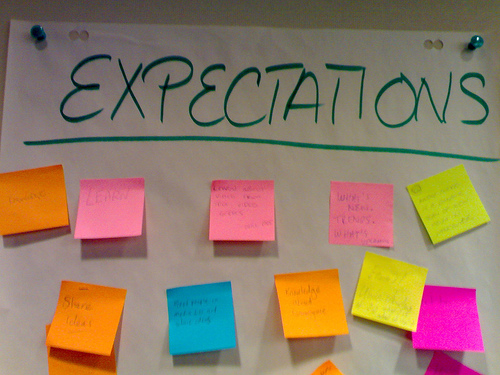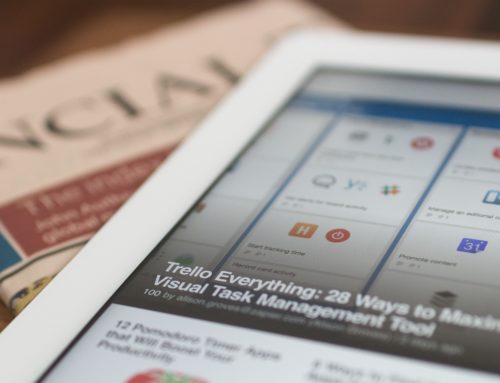 Guest Post by Adam Toporek
Guest Post by Adam Toporek
All great customer experiences are built upon expectations.
An organization can deliver a customer experience that exceeds industry norms by a factor of 10, but if the customer was expecting one that was 11 times better, the organization has failed.
Image: Roland Tanglao via Flickr, CC 2.0
Expectations are everything in customer service, and PR professionals play an important role in creating customer expectations.
Where do customer expectations come from?
For new customers, the expectations they bring with them to their first interaction with an organization can come from a variety of sources, both in and out of the organization’s control. Marketing, word-of-mouth, and online commentary are just a few examples. Public relations is another.
Back in October 2012, I wrote a post with a similar theme to this piece entitled Tell Marketing: The Customer Experience Begins With Them. In the piece, we discussed some of the influences on customer expectations:
“Just as often though, the first experience a potential customer has with your company is through exposure to your marketing. And that step is within your control.
Obviously, marketing has its own objectives ”” to drive new customers, to establish awareness, etc. Yet, once a marketing strategy is under consideration, an additional layer of analysis is deserved, one that analyzes the way an ad or campaign fits into a holistic view of the customer experience.”
You can easily substitute public relations for marketing in the above excerpt.
Communication Carries Multiple Messages
Imagine a campaign for a new cracker.
Someone in a C-Suite somewhere decides that the product should appeal to 18-29 year olds, and Marketing creates an edgy campaign that includes visuals of big wave surfing, motocross racing, and base jumping. PR creates a messaging strategy to support that.
One problem: the product is not edgy.
It is an unseasoned cracker, and the customers who try it expecting a “radical taste explosion” are immediately disappointed. The expectations being set upstream are not being met downstream, but it does not have to be this way.
PR can have a marked effect on customer satisfaction and loyalty by simply considering the impact its messaging strategy has on customer expectations.
Yet, when was the last time Operations or Customer Service was brought in to help with development of a messaging strategy?
Publicity is only one part of public relations.
But it is an obvious part, so let’s take a hypothetical example from the world of movie publicity.
It’s 1988 and Bruce Willis is doing the rounds on the talk shows to publicize Die Hard, a movie that is now fairly universally lauded as one of the great action films of all time. So, what if Bruce Willis had been told by the film’s PR people that the relationship with the wife was the heart of Die Hard, and Willis went around promoting the film as an epic love story in the tradition of Cleopatra.
Or perhaps the film’s PR team thought the character arc of John McClane was the real strength of the story, and Willis was advised to pitch the movie as a great character study in the vein of Citizen Kane.
Would moviegoers who went to Die Hard with these expectations have been disappointed? Of course. And in this extreme example, we can see what happens with products and services on a more subtle level all the time.
The expectations, either explicit or implicit, that are communicated by PR and Marketing affect customer expectations and customer satisfaction downstream. You need to go no further than the Segway for the textbook example of how expectations set by PR and Marketing could not be met by the product.
What Doesn’t Get Measured Is Still Important.
I will leave how PR is measured to experts like Shonali, but I think we can all agree that PR and Marketing metrics do not usually include customer satisfaction or retention. Sure, the connection between messaging and customer expectations might be too far removed for effective measurement, but the link is undoubtedly there.
Customer expectations are neither controllable nor easily predictable. However, some of the inputs that help create customer expectations are within our control and messaging is one of those.
So, even though the relationship between PR and customer expectations will never be linear, and even though PR will likely never be judged on customer service metrics, PR should still take into account the effect its messaging strategy will have on customer expectations.
After all, a rising balance sheet lifts all departments.
 Adam Toporek is a customer service professional, franchise developer, and small business owner who runs the popular customer experience blog Customers That Stick. He is the the author of 7 Secret Techniques Every Customer Service Expert Knows and the owner of CTS Service Solutions, a consultancy dedicated to effective, real-world customer experience solutions.
Adam Toporek is a customer service professional, franchise developer, and small business owner who runs the popular customer experience blog Customers That Stick. He is the the author of 7 Secret Techniques Every Customer Service Expert Knows and the owner of CTS Service Solutions, a consultancy dedicated to effective, real-world customer experience solutions.
![[EVENT]: PR Hacks for Small Biz (online)](https://shonaliburke.com/wp-content/uploads/2021/06/FB-Ad-1200x800-01-01-01-Copy-500x383.jpeg)








[…] I think much the same can be said of social business. If social business entails doing what we did before, but using social media and related technologies to do it, then I think we’re all missing a massive opportunity. […]
[…] I think much the same can be said of social business. If social business entails doing what we did before, but using social media and related technologies to do it, then I think we’re all missing a massive opportunity. […]
[…] Why Public Relations Should Remember Customer Expectations (waxingunlyrical.com) […]
[…] Public Relations (more on PR and customer expectations) […]
Congrats!! some very good views expressed on the importance of a PR communication in regards to customer expectation. I would like to ask for your suggestions in this regard that how can a PR take communication altogether at a different level if he/she has to attract the TA(target audience) for an eCommerce business in a B2B scenario.
kumarjit Thank you for your comment. I think I’ll defer to the PR pros around here and let them answer your question.
Adam | Customer Experience As one of the PR pros around here, kumarjit, I’d say that’s the kind of thing we get paid to consult on. :) Ultimately, PR is PR, managing customer expectation is doing just that, whichever segment you work in. If you follow the right principles, and customize them for your own situation, you are like to succeed.
Such a terrific post, Adam! To me, this is one of the most important reasons it’s critical to involve PR before any creative is developed – because there might be “hidden” messaging, or implications that the creative department simply hasn’t considered, that PR will bring up.
I also think PR can be really helpful as products are being developed; perhaps not at the absolute early stages, but certainly in the testing phase. The questions we ask often help refine how the product/service will be talked about, and clarifies it further in the minds of the creators/developers… and we definitely come up with a bunch of “why” questions as well… maybe because we are so used to anticipating those questions from the media and the public.
I’ve started to see a lot of SaaS companies especially do this when it comes to engaging external influencers – people like Soulati | B2B Social Media Marketing, ginidietrich, geoffliving and, er, even me (!) – which I think is great, because it’s a very smart way of building a community before they actually go out to build a community. I do wonder, though, if they are involving their own PR people/departments in the process as well… if they aren’t, they should be.
Shonali You’re right (of course); it works in that direction as well. It’s really about open communication and creating a feedback loop where PR can help shape the product/service and where it can also be aware of the realities of the product/service when creating expectations in the marketplace.
PS. Thanks for letting me GP at your place! I enjoyed it.
Adam | Customer Experience Thank YOU for a terrific post! I don’t think we even had to edit it… if anything, barely, right karelyneve ?
Shonali Adam | Customer Experience karelyneve Yep! Great job Adam.
Again, sorry for all my first words being off in the comment box; I cannot see them.
Soulati | B2B Social Media Marketing I have a hard time using the iPad for commenting too. More the typing thing though…
gret post, Adam…I have no idea what that first word is b/c the vertical share bar on my iPad is in the way!
What would you say about an excellent customer service IRL experience that fails when the customer walks away instead of buying?
I just left one of the more pressurized buying opportunities in awhile. Good blog post fodder! I sat in front of Hilton Grand Vacations for 2 hours. When I said no to the first guy after calling my folks for that voice of reason, another guy came over and offered me a trip to Hawaii for 7 nights at $1600 which would freeze my offer for 18 months and be put toward the down payment.
IwI wanted to buy so badly; but, I walked. For me, it was hard. I never say no; some way I wiill make it work.
the buy said 250 families a day come in for 1:1 presentations to buy “time share” at 9000 places in the world, any week. That’s hot lead generation and I have nothing but good things to say about what they offer and the 67yo who tried to sell me.
In my book, it wasn’t the customer service that failed; it was the customer’s timing. That should not be a failure in sales. Not sure this is relevant totally to your post up here, but I just left the presentation and it’s still resonant with me.
Soulati | B2B Social Media Marketing Glad to see you stood your ground. :) Not to paint all time shares with the same brush, or even a negative brush, but most are built around a “hard sell” model. That’s why they can afford to bring families in, feed them, lodge them, etc. They know they can close at a rate high enough and their product is profitable enough that paying an extraordinary price per lead is worth it. Also, by giving you so much, they are able to push those reciprocity triggers pretty hard.
That being said, what I really took away from your comment is that you are buying me a trip to Hawaii. Did I read that right? :)
Yeah, but you just became a puppy dad so no way can you leave the kids!
Your post recalls one I read the other day that talked about how some people use marketing as a substitute for customer experience. It’s a flawed idea as your post points out. Marketing and PR create expectations and aren’t Band-Aids for poor customer service or poor products.
You make a good point Erin. It’s bad enough when marketing or PR creates expectations that cannot be met through the customer experience. It’s even worse to think that marketing can make up for a bad experience.